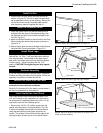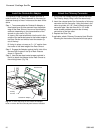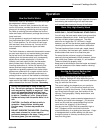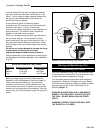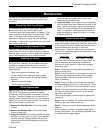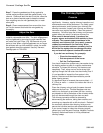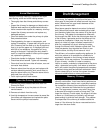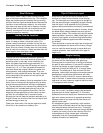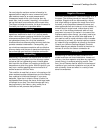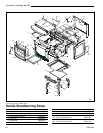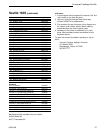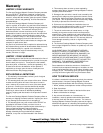
22
Vermont Castings Seville
30001490
Step 7. Press the gasketed part firmly against its
normal mating surface to seat the gasket evenly in its
channel. Close and latch the door to do this; close the
door on a piece of waxed paper to keep the cement
from migrating onto the non-gasketed part, or mask
other parts
Step 8. Clean excess cement from around the chan-
nel. Let the cement that holds the new gasket dry
thoroughly.
Adjust the Door
The door latch may need adjustment as the gasket
material compresses over time. The latch engagement
may be tightened by removing the shim washers that
are under the Latch Plate. (Fig. 29) Remove only one
pair at a time. When a tight engagement can no longer
be achieved with no shim washers in place, the entire
door gasket should be replaced. Use only Vermont
Castings part no. 700-0910.
Shim Washers
Latch Plate
ST268
Fig. 29 Remove shim washers to tighten latch engagement.
The Chimney System
Creosote
Your Seville is designed to reduce creosote buildup
significantly. However, regular chimney inspection and
maintenance must still be performed. For safety, good
stove performance, and to protect your chimney and
chimney connector, inspect your chimney and chimney
connector on a regular schedule. Clean the system if
necessary. Failure to keep the chimney and connector
system clean can result in a serious chimney fire.
When wood is burned slowly, it produces tar,
organic vapors and moisture that combine to form
creosote. The creosote vapors condense in the
relatively cool chimney flue. As a result, creosote
residue accumulates on the flue lining. When
ignited, this creosote makes an extremely hot fire
within the flue system that can damage the chim-
ney and overheat adjacent combustible material.
If you do have a chimney fire, promptly:
• Close the thermostat lever.
• Get everyone out of the house.
• Call the Fire Department.
You should inspect the system every two weeks during
the heating season as part of a regular maintenance
schedule. To inspect the chimney, let the stove cool
completely. Then, using a mirror and a strong light,
sight up through the flue collar into the chimney flue. If
it is not possible to inspect the flue system in this
fashion, the stove must be disconnected to provide
better viewing access.
If a significant layer of creosote has accumulated —1/
8" (3 mm) or more — remove it to reduce the risk of a
chimney fire.
Clean the chimney using a brush the same size and
shape as the flue liner. Flexible fiberglass rods are
used to run the brush up and down the liner, causing
any deposits to fall to the bottom of the chimney where
they can be removed through the clean-out door.
The chimney connector should be cleaned by
disconnecting the sections, taking them outside, and
removing any deposits with a stiff wire brush. Reinstall
the connector sections after cleaning, being sure to
secure the individual sections with sheet metal screws.
If you cannot inspect or clean the chimney yourself,
contact your local Vermont Castings, Majestic Products
Company Authorized Dealer or hire a professional
chimney sweep.





